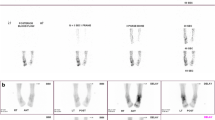Abstract
Objective: To investigate the role of quantitative three phase bone scintigraphy (QTPBS) in the evaluation of efficacy of intravenous regional blockade treatment in patients having reflex sympathetic dystrophy (RSD) of the upper extremity.Material and Methods: Twenty-six patients with stage-I RSD were focused on in this study. Patients were treated with physical therapy and intravenous (I.V.) regional blockade therapy consisting of dexamethasone and lidocaine. All patients were clinically evaluated before and 1 month after the completion of the therapy protocol. QTPBS was applied to patients before therapy and 1 month after the therapy. As a control group, 11 healthy subjects also underwent QTPBS. Perfusion, hyperemic and fixation indices were calculated from three-phase bone scintigraphy.Results: All patients showed statistically significant clinical improvement after the therapy (p < 0.01). Pre-treatment, perfusion (1.67 ± 0.63), hyperemic (1.44 ± 0.48) and fixation (1.69 ± 0.48) indices of patients were higher than those of healthy subjects (PI: 0.95 ± 0.05, HI: 0.94 ± 0.06, FI: 1.01 ± 0.2) (p < 0.01) and all indices significantly decreased after the treatment (PI: 1.33 ± 0.46, HI: 1.18 ± 0.23, FI: 1.42 ± 0.26) (p < 0.01).Conclusion: I.V. regional blockade therapy combined with corticosteroids is a simple, safe and effective method for the treatment of patients with stage-I RSD in the upper extremity. QTPBS is a valuable and objective method to evaluate the response to therapy and may be useful for staging of patients and predicting the response to therapy.
Similar content being viewed by others
References
Veldman PHJM, Reynen HM, Arntz IE, Goris RJ. Signs and symptoms of reflex sympathetic dystrophy: Prospective study of 829 patients.Lancet 1993; 342: 1012–1016.
Boas RA. Complex regional pain syndromes: Symptoms, signs and differential diagnosis. In: Janig W, Stanton-Hicks M (eds).Reflex sympathetic dystrophy: A Reappraisal. Seattle, WA; IASP Press, 1996: 79–92.
Kozin F . Painful shoulder and the reflex symphatetic dystrophy syndrome. In: Koopmann WJ (ed).Arthritis and Allied Conditions. 13th edition. Philadelphia; 1997: 1908–1922.
Derbekyan W, Novales-Dias J, Lisbona R. Pancoast tumor as a cause of reflex sympathetic dystrophy.J Nuc Med 1993; 34: 1992–1994.
Scwartman RJ, McLellan TL. Reflex sympathetic dystrophy: A review.Arch Neurol 1987; 44: 555.
Zyluk A. The reasons for poor response to treatment of posttraumatic reflex sympathetic dystrophy.Acta Orthop Belg 1998; 64: 309–313.
Kozin F, Soin JS, Ryan LM, Carrera GF, Wortmann RL. Bone scintigraphy in reflex sympathetic dystrophy.Radiology 1981; 138: 437–443.
Mackinnon S, Holder L. The use of three-phase radionuclide bone scanning in the diagnosis of reflex sympathetic dystrophy.J Hand Surg 1984; 9A: 556–563.
Demangeat JL, Constantinesco A, Brunot B, Foucher G, Farcot JM. Three-phase bone scanning in reflex sympathetic dystrophy of the hand.J Nucl Med 1988; 29: 26–32.
Atkins RM, Tindale W, Bickerstaff D, Kanis JA. Quantitative bone scintigraphy in reflex sympathetic dystrophy.Br J Rheumatol 1993; 32: 41–45.
Zyluk A, Birkenfeld B. Quantitative evaluation of three- phase bone scintigraphy before and after the treatment of post-traumatic reflex sympathetic dystrophy.Nucl Med Commun 1999; 20: 327–333.
Bickerstaff DR, Kanis JA. The use of nasal calcitonin in the treatment of post-traumatic algodystrophy.Br J Rheumatol 1991; 30: 291–294.
Fialka V, Zifko I, Bochdansky T, Schneider B, Schimmert S. Late sequelae of reflex sympathetic dystrophy: Results of clinical, scintigraphic and dynamometric investigations.Eur J Phys Med Rehab 1991; 3: 59–64.
Rosenthal A, Wortmann R. Diagnosis, pathogenesis and management of reflex sympathetic dystrophy syndrome.Comprehensive Therapy 1991; 17: 46–50.
Poplawski EJ, Wiley AM, Murray JF. Post-traumatic dystrophy of the extremities.J Bone Joint Surg 1983; 65A: 642–649.
Desai A, Intenzo C. Tourniquet effect.J Nucl Med 1984; 25: 697–699.
Leitha T, Staudenherz A, Korpan M, Fialka V. Pattern recognition in five-phase bone scintigraphy: diagnostic patterns of reflex sympathetic dystrophy in adults.Eur J Nucl Med 1996; 23: 256–262.
Mudun A, Bursali A, Oklu T, Araci A, Silahci H, Cantez S. Scintigraphic evaluation of the effectiveness of intranasal calcitonin therapy in Sudeck’s atrophy.Nucl Med Commun 1993; 14: 805–809.
Werner R, Davidoff G, Jackson D, Cremer S, Ventocilla C, Wolf L. Factors affecting the sensitivity and specificity of the three-phase bone scan in the diagnosis of reflex sympathetic dystrophy in the upper extremity.J Hand Surg 1989; 14A: 520–523.
Blocux P, Drussens M. The use of99mTc-HSA dynamic vascular examination in the staging and therapy of monitoring of reflex sympathetic dystrophy.Nucl Med Commun 1991; 12: 725–731.
Hoffman J, Phillips W, Blum M, Barohn R, Ramamurthy S. Effect of sympathetic block demonstrated by triple-phase bone scan.J Hand Surg 1993; 18: 860–864.
Siegel BA, Donovan RL, Alderson PO, Mack GR. Skeletal uptake of Tc-99m Diphosphonate in relation to level bone blood flow.Radiology 1976; 120: 121–123.
Genant HK, Bautovich GJ, Singh M, Lathrop KA, Harper PV. Bone seeking radionuclides: anin vivo study of factors affecting skeletal uptake.Radiology 1974; 113: 373–382.
Tauntas AA, Noguchi A. Treatment of reflex sympathetic dystrophy syndrome (RSDS) with intravenous blocks of a mixture of corticosteroids and lidocaine: a retrospective review of 17 consecutive cases.J Orthop Trauma 1991; 5: 412–419.
Zyluk A. Results of the treatment of posttraumatic reflex sympathetic dystrophy of the upper extremity with regional intravenous blocks of methylprednisolone and lidocaine.Acta Orthop Belg 1998; 64: 452–456.
Author information
Authors and Affiliations
Corresponding author
Rights and permissions
About this article
Cite this article
Öztürk, E., Möhür, H., Arslan, N. et al. Quantitative three-phase bone scintigraphy in the evaluation of intravenous regional blockade treatment in patients with stage-i reflex sympathetic dystrophy of upper extremity. Ann Nucl Med 18, 653–658 (2004). https://doi.org/10.1007/BF02985958
Received:
Accepted:
Issue Date:
DOI: https://doi.org/10.1007/BF02985958




